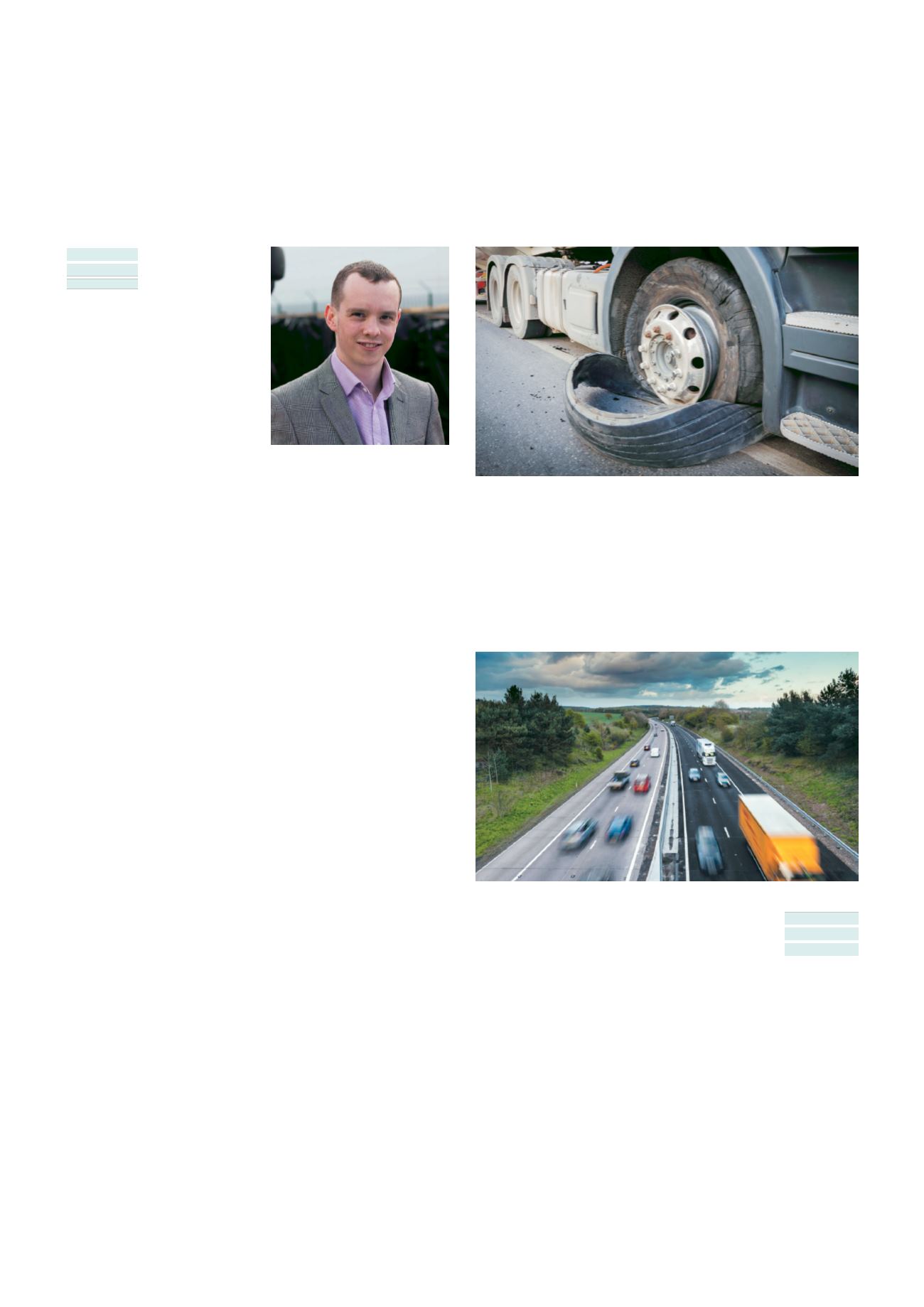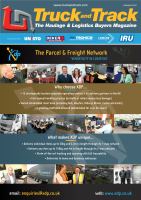

Truck and Track
June/July 2017
www.truckandtrack.com36
TYRES
Truck tyres are designed
to carry heavy loads, and
therefore their construction
is much stronger than those
on a car. Tyre sidewalls are
thicker, and the tread is
deeper, enabling the vehicle
to carry the extra weight
of the cargo and the truck
itself. The tyre pressure of an
HGV is also higher than on
smaller vehicles. An HGV tyre
can be inflated to up 120psi,
compared to a standard car
tyre which is around 40psi.
Accordingly, when a truck tyre delaminates and blows out, it
does so with extreme force. Pieces of rubber and tyre carcass
can fly at high speed and over long distances.
Consequences of a tyre blowout
A blowout can have disastrous consequences for both the driver
and other road-users. While most people believe that a blowout
is unpredictable, its likelihood can be detected in advance. The
first stage of a blowout is usually a puncture. As the tyre begins
to deflate, there is more friction with the road, which causes the
tyre temperature to rise. The tyre wall then begins to overheat and
eventually collapses. Because of the increased pressure on the tyre,
this process happens much more quickly in heavy goods vehicles.
In the case of a blowout, the vehicle is likely to pull strongly to the
left or right, depending onwhich tyre has burst. As you can imagine,
when driving a long vehicle, this is even more difficult to control. If
the HGV is using a trailer to carry its load, the vehicle and its load
may swerve in opposite directions. Even if the driver can regain
control, there may still be damage to the vehicle and surrounding
traffic.
When a truck tyre blows, a driver’s natural reaction is to brake.
However, braking will cause the blown tyre to drag even harder on
the road, intensifying the vehicle’s pull. The best thing for a driver
to do is accelerate slightly, lifting the weight off the blown out tyre.
The driver should grip the steering wheel firmly and refrain from
over-steering. The vehicle should slowly come to a stop, as the
driver starts to ease off the acceleration.
Prevention is better than cure
Knowing how to handle a blowout is certain to improve the safe
driving of an HGV under emergency conditions. However, doing
everything possible to prevent the blowout from happening in the
first place is the better course of action by far.
Keeping a regular check on tyre pressures is the best way to do
this. Drivers can check tyre pressures whilst driving by using a
tyre pressure monitoring system (TPMS), which shows realtime
information on tyre pressure and temperature.
Introducing the TeleTPMS smart module
While the TPMS allows drivers to stay in control of their vehicle,
fleet managers can go one step further in taking responsibility.
Removing the need to rely upon drivers to monitor tyre pressures,
the TeleTPMS smart module communicates and transmits tyre
pressure and temperature measurements to a remote database.
This valuable data is accessible to the fleet manager on a desktop
or laptop computer, tablet or web application. Providing the fleet
manager with visualisation of all fleet vehicles, the TeleTPMS
system uses coloured displays to indicate the performance of each
vehicle and the condition of its tyres.
TyrePal’s TeleTPMSoperateswhile the vehicle is inmotionandwhen
stationary, practically eliminating any potential blowout or tyre
fire. Even in the event of a small puncture, warnings will be issued,
so that action can be undertaken before a tyre is permanently
damaged.
Road haulage is a key service industry for the UK economy. Every
year the industry grows, and it is expected to continue to do so in
2017. While this is fantastic news for the industry, it means that
fleet managers need to take road safety even more seriously, as UK
motorways become ever more congested.
TyrePal is totally independent of all tyre manufacturers or tyre
service providers. The company supplies tyre pressure monitoring
systems to private and commercial end-users, OEMs and service
providers such as telematics and fleet tyre suppliers.
For more information on how to improve tyre safety, visit
www.tyrepal.co.uk orcontact Peter Tillotson at TyrePal, a division
of Wheel Solutions Ltd, 2 Upper Keys Business Park, Keys Park
Road, Hednesford, Cannock, Staffs, WS12 2GE. Tel 01543 870 190,
mobile 07973 601 998, email
pt@wsl.uk.com.To keep up-to-date with press material and opinion-focussed
content from TyrePal, you can visit their company blog page
www.tyrepal.co.uk/tyre-pressure-news.Twitter:
https://twitter.com/TyrePal.Linkedin:
https://www.linkedin.com/company/tyrepal-ltd.Reducing the risks in road haulage
“
In 2016 1.65 billion tonnes of goods were transported on UK roads. As the road haulage industry
continues to expand, driver and road safety are becoming more important than ever before. In this
commentary Peter Tillotson, Business Development Manager of tyre pressure monitoring specialist
TyrePal, discusses the best ways for fleet managers to improve tyre safety on their HGVs.
”
Peter Tillotson of TyrePal



















